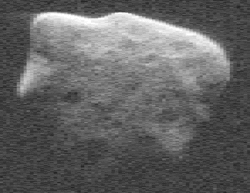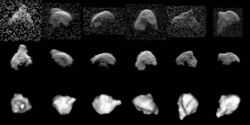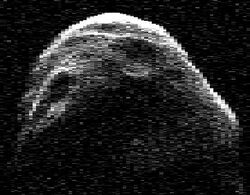Astronomy:(53319) 1999 JM8
 | |
| Discovery[1][2] | |
|---|---|
| Discovered by | LINEAR |
| Discovery site | Lincoln Lab's ETS |
| Discovery date | 13 May 1999 |
| Designations | |
| (53319) 1999 JM8 | |
| 1999 JM8 · 1990 HD1 | |
| Minor planet category | NEO · PHA · Apollo[1][2] Mars-crosser |
| Orbital characteristics[1] | |
| Epoch 2022-Aug-09 (JD 2459800.5) | |
| Uncertainty parameter 0 | |
| Observation arc | 31.03 yr |
| |{{{apsis}}}|helion}} | 4.4741 AU |
| |{{{apsis}}}|helion}} | 0.9759 AU |
| 2.7236 AU | |
| Eccentricity | 0.6417 |
| Orbital period | 4.49 yr (1,642 days) |
| Mean anomaly | 19.009° |
| Mean motion | 0° 13m 8.4s / day |
| Inclination | 13.842° |
| Longitude of ascending node | 133.62° |
| 166.83° | |
| Earth MOID | 0.0258 AU (10.0 LD) |
| Jupiter MOID | 0.85 AU |
| Physical characteristics | |
| Dimensions | 5 km[3] 5.4±1.2 km[4] 6.4 km[5] 7 km[6][7] |
| Rotation period | 136±2 h[8] |
| Geometric albedo | 0.02±0.01[4] 0.03 (derived)[9] |
| SMASS = X:[1] · C[10] X(Tholen)[9] | |
| Absolute magnitude (H) | 15.00[10] · 15.14±0.38[11] · 15.2[1][9] · 16.5[4] |
(53319) 1999 JM8 is an asteroid, slow rotator and tumbler, classified as a near-Earth object and potentially hazardous asteroid (PHA) of the Apollo group, approximately 7 kilometers (4 miles) in diameter, making it the largest PHA known to exist.[12] It was discovered on 13 May 1999, by astronomers of the Lincoln Near-Earth Asteroid Research at the Lincoln Laboratory's Experimental Test Site near Socorro, New Mexico.[2]
Orbit and classification
1999 JM8 orbits the Sun at a distance of 1.0–4.5 AU once every 4 years and 6 months (1,644 days; semi-major axis of 2.73 AU). Its orbit has an eccentricity of 0.64 and an inclination of 14° with respect to the ecliptic.[1] This makes it also a Mars-crossing asteroid.
The body's observation arc begins with its first identification as 1990 HD1 at Palomar Observatory in April 1990, more than 9 years prior to its official discovery observation at Socorro.[2]
Close approaches
1999 JM8 has an Earth minimum orbital intersection distance of 0.0258 AU (3,860,000 km; 10.0 LD)[1] It passed closer than 0.20 AU to the Earth five times in the last century (0.033 AU in 1990), but its next closest approach in the 21st century will be in 2075 at 0.256 au (38,300,000 km; 23,800,000 mi; 100 LD) and in August 2137 at 0.0764 au (11,430,000 km; 7,100,000 mi; 29.7 LD).[1] For comparison, the planet Venus passed 103 LD (40,000,000 km; 25,000,000 mi) from Earth in 2022.
Physical characteristics
In the SMASS and Tholen classification, 1999 JM8 is an X-type asteroid.[1][9] It has also been characterized as a carbonaceous C-type asteroid, which seems more likely due to its exceptionally low albedo (see below).[10]
Rotation period
Radar imaging by Goldstone and Arecibo observatories revealed that 1999 JM8 has an unusually slow and possibly chaotic rotation period, similar to that of asteroid 4179 Toutatis.[9][5]
In July 1999, a rotational lightcurve of 1999 JM8 was obtained from photometric observations. It gave a period of 136±2 hours with a brightness amplitude of 0.7 magnitude ({{{1}}}), and suggested that the body is in a non-principal axis rotation, commonly known as tumbling.[8]
Diameter and albedo
1999 JM8 measures between 5 and 7 kilometers in diameter and its surface has an exceptionally low albedo of 0.02.[3][4][6][7] The Collaborative Asteroid Lightcurve Link derives an albedo of 0.03 and adopts a diameter of 7 kilometers based on an absolute magnitude of 15.2.[9]
Numbering and naming
This minor planet was numbered by the Minor Planet Center on 16 February 2003.[13] As of 2018, it has not been named.[2]
References
- ↑ 1.0 1.1 1.2 1.3 1.4 1.5 1.6 1.7 1.8 "JPL Small-Body Database Browser: 53319 (1999 JM8)". Jet Propulsion Laboratory. https://ssd.jpl.nasa.gov/sbdb.cgi?sstr=2053319. Retrieved 23 November 2017.
- ↑ 2.0 2.1 2.2 2.3 2.4 "53319 (1999 JM8)". Minor Planet Center. https://www.minorplanetcenter.net/db_search/show_object?object_id=53319. Retrieved 23 November 2017.
- ↑ 3.0 3.1 Benner, L. A. M.; Nolan, M. C.; Margot, J.-L.; Giorgini, J. D.; Hudson, R. S.; Jurgens, R. F. et al. (May 2001). "Recent Radar Observations of Four Near-Earth Asteroids". American Astronomical Society 33: 918. Bibcode: 2001AAS...198.8907B. http://adsabs.harvard.edu/cgi-bin/bib_query?bibcode=2001AAS...198.8907B. Retrieved 23 November 2017.
- ↑ 4.0 4.1 4.2 4.3 Reddy, Vishnu; Gaffey, Michael J.; Abell, Paul A.; Hardersen, Paul S. (May 2012). "Constraining albedo, diameter and composition of near-Earth asteroids via near-infrared spectroscopy". Icarus 219 (1): 382–392. doi:10.1016/j.icarus.2012.03.005. Bibcode: 2012Icar..219..382R. http://adsabs.harvard.edu/cgi-bin/bib_query?bibcode=2012Icar..219..382R. Retrieved 23 November 2017.
- ↑ 5.0 5.1 Brozovic, M.; Benner, L. A. M.; Nolan, M. C.; Ostro, S. J.; Margot, J. L.; Giorgini, J. D. et al. (May 2012). "Shape Modeling of Near-Earth Asteroid (53319) 1999 JM8 from Goldstone and Arecibo Radar Images". Asteroids 1667: 6183. Bibcode: 2012LPICo1667.6183B. http://adsabs.harvard.edu/cgi-bin/bib_query?bibcode=2012LPICo1667.6183B. Retrieved 23 November 2017.
- ↑ 6.0 6.1 Benner, L. A. M.; Ostro, S. J.; Nolan, M. C.; Margot, J.-L.; Giorgini, J. D.; Hudson, R. S. et al. (November 2001). "Radar Observations of Asteroid 1999 JM8". American Astronomical Society 33: 1153. Bibcode: 2001DPS....33.6106B. http://adsabs.harvard.edu/cgi-bin/bib_query?bibcode=2001DPS....33.6106B. Retrieved 23 November 2017.
- ↑ 7.0 7.1 Benner, Lance A. M.; Ostro, Steven J.; Nolan, Michael C.; Margot, Jean-Luc; Giorgini, Jon D.; Hudson, R. Scott et al. (June 2002). "Radar observations of asteroid 1999 JM8". Meteoritics and Planetary Science 37 (6): 779–792. doi:10.1111/j.1945-5100.2002.tb00855.x. Bibcode: 2002M&PS...37..779B. http://adsabs.harvard.edu/cgi-bin/bib_query?bibcode=2002M&PS...37..779B. Retrieved 23 November 2017.
- ↑ 8.0 8.1 Pravec, P.; Harris, A. W.; Scheirich, P.; Kusnirák, P.; Sarounová, L.; Hergenrother, C. W. et al. (January 2005). "Tumbling asteroids". Icarus 173 (1): 108–131. doi:10.1016/j.icarus.2004.07.021. Bibcode: 2005Icar..173..108P. http://adsabs.harvard.edu/cgi-bin/bib_query?bibcode=2005Icar..173..108P. Retrieved 23 November 2017.
- ↑ 9.0 9.1 9.2 9.3 9.4 9.5 "LCDB Data for (53319)". Asteroid Lightcurve Database (LCDB). http://www.minorplanet.info/PHP/generateOneAsteroidInfo.php?AstInfo=53319%7C. Retrieved 23 November 2017.
- ↑ 10.0 10.1 10.2 Carry, B.; Solano, E.; Eggl, S.; DeMeo, F. E. (April 2016). "Spectral properties of near-Earth and Mars-crossing asteroids using Sloan photometry". Icarus 268: 340–354. doi:10.1016/j.icarus.2015.12.047. Bibcode: 2016Icar..268..340C. http://adsabs.harvard.edu/cgi-bin/bib_query?bibcode=2016Icar..268..340C. Retrieved 23 November 2017.
- ↑ Veres, Peter; Jedicke, Robert; Fitzsimmons, Alan; Denneau, Larry; Granvik, Mikael; Bolin, Bryce et al. (November 2015). "Absolute magnitudes and slope parameters for 250,000 asteroids observed by Pan-STARRS PS1 - Preliminary results". Icarus 261: 34–47. doi:10.1016/j.icarus.2015.08.007. Bibcode: 2015Icar..261...34V. http://adsabs.harvard.edu/cgi-bin/bib_query?bibcode=2015Icar..261...34V. Retrieved 23 November 2017.
- ↑ "3200 Phaethon". https://echo.jpl.nasa.gov/asteroids/Phaethon/Phaethon_planning.2017.html.
- ↑ "MPC/MPO/MPS Archive". Minor Planet Center. https://www.minorplanetcenter.net/iau/ECS/MPCArchive/MPCArchive_TBL.html. Retrieved 24 February 2018.
External links
| Wikimedia Commons has media related to (53319) 1999 JM8. |
- Asteroid Lightcurve Database (LCDB), query form (info )
- Asteroids and comets rotation curves, CdR – Observatoire de Genève, Raoul Behrend
- (53319) 1999 JM8 at NeoDyS-2, Near Earth Objects—Dynamic Site
- Ephemeris · Obs prediction · Orbital info · MOID · Proper elements · Obs info · Close · Physical info · NEOCC
- (53319) 1999 JM8 at ESA–space situational awareness
- (53319) 1999 JM8 at the JPL Small-Body Database
 |



